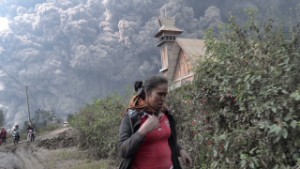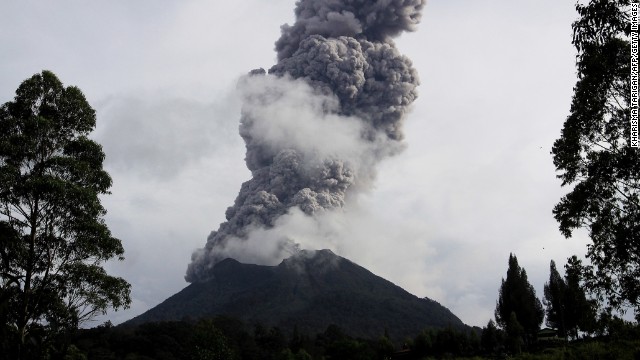Could the explosion of Iceland's ticking time bombs cause cold and famine worldwide? Now a threatening Icelandic volcano, Katla, has begun to swell and grumble. Two more giants, Hekla and Laki, could erupt without warning.
(22,000 people had been evacuated recently near this Indonesian volcano. 11,000+ were allowed to return last Friday!):
Volcanic ash smothers part of Indonesia, kills 15
updated 1:29 AM EST, Sun February 2, 2014
STORY HIGHLIGHTS
- Hot ash up to 700 degrees raced down the mountain's slope in just a few minutes
- Jakarta Post: This is the first time Mount Sinabung's eruptions have resulted in deaths
- A recovery operation was scheduled for Sunday
Jakarta, Indonesia (CNN) -- The 15 victims simply couldn't outrun the searing debris that billowed out of Indonesia's Mount Sinabung.
Plumes of ash had spewed more than a mile into the sky Saturday and descended in superheated clouds. Scalding ash up to 700 degrees in temperature raced down the slope in just two to three minutes.
By the end of several eruptions, at least 15 people had been killed, a government official told CNN. It was the first time Mount Sinabung's volcanic output had resulted in deaths, the Jakarta Post reported.
On Sunday, the sky above the North Sumatra mountain was still the color of murky gray ash, as shown on video from the Indonesia Geologic Agency.

The victims, and at least three other injured people, were all found in Sukameriah, a village close to the volcano's crater, disaster mitigation agency spokesman Sutopo Purwo Nugroho told CNN.
Local search-and-rescue teams were scheduled to go on a recovery operation Sunday, he said.
Eruptions at Mount Sinabung are becoming common. After about 400 years of minimal volcanic activity there, Sinabung erupted in 2010. It has been emitting gas since September.
The English-language Jakarta Post said while 31 people previously had died from eruption-related illnesses such as asthma and hypertension.
The unpredictable volcanic volatility has meant an itinerant existence for those who live in this region a 2½ hour flight from Jakarta. Last month, intensifying volcanic activity forced 22,000 people into temporary camps, but more than half were allowed to return home on Friday.

The newest volcanic activity has forced people to evacuate 16 villages, the Jakarta Post reported. At least 30,000 people have been temporarily housed at 42 evacuation centers, according to Billy Sumuan, the emergency response director in Indonesia for the humanitarian group World Vision.
Saturday's victims lived within a 3-kilometer radius of the volcano. Some were there checking on their homes or were there just to watch the eruptions, Nugroho said. Others were students and volunteers in the region to help its beleaguered people, Sumuan said.
The government had issued the highest level of alert for the latest eruptions, and Sumuan noted that no one was supposed to go inside a 5-kilometer zone around the volcano.
Several government agencies and nongovernmental humanitarian groups were on the scene Sunday helping those affected, including World Vision, which Sumuan said was helping children with their trauma and hygiene. The government and local churches handed out masks to everyone to mitigate breathing problems, he said.
Kathy Quiano wrote and reported on this story from Indonesia, Brian Walker reported from Atlanta, and Mark Morgenstein wrote and reported from Atlanta.


 Mount Sinabung fills the sky over Karo, North Sumatra, Indonesia, with smoke and ash as it erupts on Saturday, February 1. The volcano has been erupting since September.
Mount Sinabung fills the sky over Karo, North Sumatra, Indonesia, with smoke and ash as it erupts on Saturday, February 1. The volcano has been erupting since September.
No comments:
Post a Comment